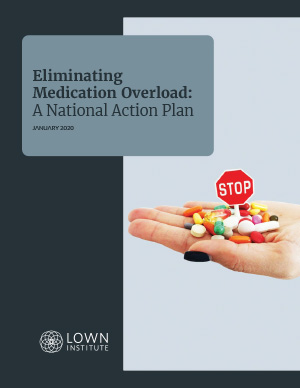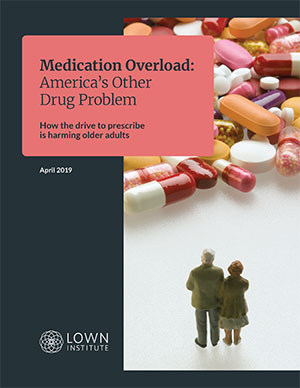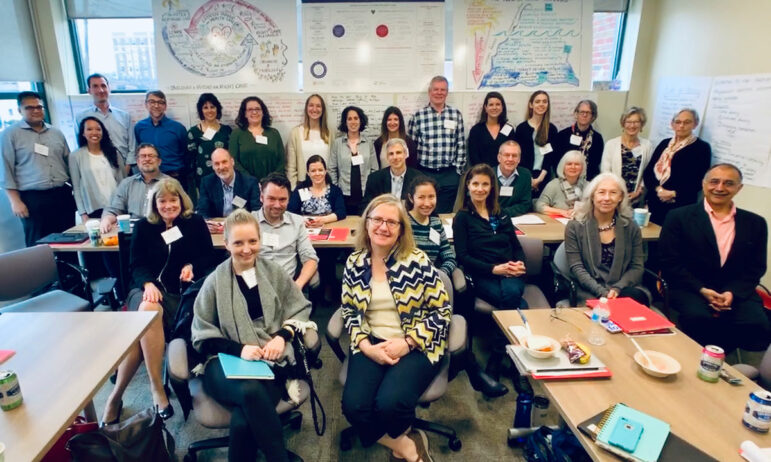Medication overload and older Americans
The United States is in the grips of an unseen epidemic of harm from the excessive prescribing of medications. If nothing is done to change current practices, medication overload will contribute to the premature deaths of 150,000 older Americans over the next decade and reduce the quality of life for millions more. (press release)
Focusing on reducing inappropriate or unnecessary medications could save as much as $62 billion over the next decade in unnecessary hospitalization for older adults alone.

Action Plan & Issue Briefs
Provides recommendations to address the main drivers of medication overload across five key categories.

Framing Paper
Examines the scope, harms, and drivers of the medication overload crisis.
Scope of Medication Overload
Every day, 750 older people living in the United States (age 65 and older) are hospitalized due to serious side effects from one or more medications. Over the last decade, older people sought medical treatment more than 35 million times for adverse drug events, and there were more than 2 million hospital admissions.
The prescribing of multiple medications to individual patients (called “polypharmacy” in the scientific literature) has reached epidemic proportions. More than four in ten older adults take five or more prescription medications, triple the rate from twenty years ago. Nearly 20 percent take ten drugs or more.
Drivers of Medication Overload
A broad array of forces is at work, with three overarching aspects of our health care system contributing to the epidemic:
Culture of Prescribing –Advertisements linking prescription medications to happiness and health, the increased medicalization of normal human aging, the hurried pace of medical care, and the desire of both health care professionals and patients to “do something” have fostered a shared expectation that there is a “pill for every ill.”
Information & Knowledge Gaps – Clinicians and patients lack critical information and skills they need to appraise the evidence and make informed decisions regarding medications.
Fragmentation of Care – There is a pervasive lack of communication between a patient’s various providers. Often, more prescriptions are written to treat what appears to be a new condition, when in reality prescribers are treating a side effect of another drug. This “prescribing cascade” can lead to a cycle of debilitation and even death.
The Costs of Medication Overload
Reducing inappropriate or unnecessary medications could save as much as $62 billion over the next decade in unnecessary hospitalizations for older adults alone. As a nation, we would also save billions more on the cost of unnecessary drugs and visits to the emergency room and outpatient clinics. More importantly, successfully tackling medication overload holds the promise of lessening disability, cognitive decline, and hospitalizations for patients. And that translates into better lives for millions of people.
Eliminating Medication Overload
Serious cultural, educational, and policy changes are needed to prevent harm from medication overload. Eliminating Medication Overload: A National Action Plan, released in January 2020, provides recommendations for policymakers, foundations, health care institutions, clinicians, and patients across five key categories:
Implement “prescription checkups,” medication reviews that give patients and clinicians opportunities to deprescribe (discontinue or reduce doses) appropriately.
Raise awareness among patients, clinicians, and the general public about the potential harms of multiple medication use.
Improve information at the point of care to ensure clinicians know exactly which medications their patients are taking, and to give clinicians accurate information about the harms and benefits of medications.
Educate and train health professionals to reduce medication overload, by incorporating information on geriatric care and deprescribing training into professional schools and continuing education.
Reduce pharmaceutical industry influence by limiting pharma sales rep visits to clinicians and direct-to-consumer advertising.

Project Team
The Lown Institute convened a working group of patients, doctors, nurses, advocates, researchers, and pharmacists to develop the action plan, over the course of 18 months.
This project was supported by funding from the Gordon and Betty Moore Foundation.
